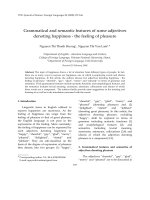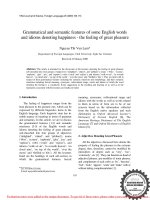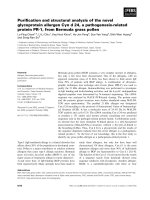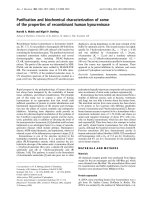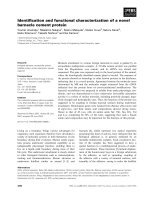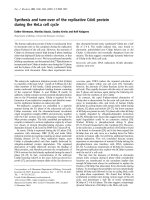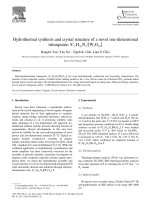Synthesis and bioacivity screening of some novel N-(Adamantan-1-yl)-1-Aryl-Methanimines
Bạn đang xem bản rút gọn của tài liệu. Xem và tải ngay bản đầy đủ của tài liệu tại đây (1.04 MB, 7 trang )
Journal of military pharmaco-medicine n02-2019
SYNTHESIS AND BIOACIVITY SCREENING OF SOME NOVEL
N-(ADAMANTAN-1-YL)-1-ARYL-METHANIMINES
Pham Van Hien1; Vu Binh Duong1; Cao Dang Nam1; Nguyen Van Tu1
Phan Thi Phuong Dung2; Nguyen Quynh Hoa3; Phan Dinh Chau4
SUMMARY
Objectives: Synthesis and bioactivity testing of some novel N-(adamantan-1-yl)-1-arylmethanimines derivatives. Methods: The novel of N-(adamantan-1-yl)-1-aryl-methanimines were
synthesized by the condensation of 1-aminoadamantane with aromatic aldehydes in absolute
ethanol under the catalyzation of acetic acid. Synthesized compounds were bioactivity tested as
inhibition of acetylcholinesterase, antimicrobial, anticancer in vitro. Results: A new series of N(adamantan-1-yl)-1- aryl-methanimines was designed, synthesized and evaluated for their
inhibition of acetylcholinesterase, antimicrobial, anticancer. Representative two compounds did
not show the inhibition of acetylcholinesterase and antimicrobials (S. aureus, B. subtilis, L.
fermentum, S. enterica, E. coli, P. aureus). However, synthesize compounds were shown to be
promising in at least three tumor cell lines with IC50 from 3.6 - 82.2 µg/mL. Otherwise, five per
ten compounds possessed the activity against C. albican. Conclusions: At the present work, it
had synthesized ten novel N-(adamantan-1-yl)-1-aryl-methanimine derivatives, between them,
some compounds were identified against C. albican and with significant cytotoxic activity in
testing tumor cell lines.
* Keywords: N-(adamantan-1-yl)-1-aryl-methanimines; Bioactivity.
INTRODUCTION
Finding for new biological agents
such as antimicrobial, inhibition of
acetylcholinesterase, anticancer is becoming
the major interest in the huge of academic
and industry research laboratories all over
the world [1]. This is due to discover new
biological agents with more specificity and
less toxicity [2], in addition to the various
types of new disease-caused agents that
are recently discovered which is becoming
a great challenge for the scientists [3].
The adamantane nucleus was found to be
important constituent in many ingredients
[4]. The incorporation of an adamantyl
moiety into a pharmacologically-activemolecule resulted in improving the
therapeutic profile of the parent drugs
[5, 6, 7]. Since the discovery of
amantadine (I) [8] as a first antiviral
therapy for systemic use, several
hundreds of 1-adamantyl derivatives were
synthesized and tested for various
biological activities including anticancer,
1. Vietnam Military Medical University
2. Hanoi University of Pharmacy
3. National Centralized Drug Procurement Center
4. Hanoi University of Science and Technology
Corresponding author: Pham Van Hien ()
Date received: 20/12/2018
Date accepted: 16/01/2019
88
Journal of military pharmaco-medicine n02-2019
antiviral (HIV, influenza, Hespes simple
virus), antimicrobial and so on [9]. However,
most of them, the synthesized routes
focused to get oxadiazoles [10], isoxazoles
[11], thiadiazoles [10], urea/thiourea
derivatives and other components.
To date, there are no findings of 1adamantylimine via condensation of
1-aminoadamantane
with
aromatic
aldehydes as well as their bioactivity. The
present study aimed to synthesize and
biological test the novel N-(adamantan-1yl)-1-aryl-methanimines derivatives.
MATERIALS AND METHODS
1. General.
All reagents were commercially available
and used without further purification.
Reactions were magnetically stirred with
reflux heating and monitored by thin-layer
chromatography (TLC) on Merck silica gel
60F-254 by fluorescence and Dragendorf
reagent. 1H-NMR and 13C-NMR spectra
were obtained Brucker AV-500 system
at 500 MHz. Chemical shilfs were given
in parts per million (ppm) relative to
tetramethylsilane (TMS) as an internal
standard. Multiplicities were abbreviated
as follows: single (s), doublet (d), multiplet
(m), and broad signal (br s). High resolution
mass spectral (HR-MS) data were acquired
on a SCIEX X500 QTOF system. Melting
points were measured on Stuart, SMP-10
micromelting and were really corrected.
* Antimicrobial screening:
The in vitro antimicrobial testing was
performed at Laboratory of Applied
Biochemistry, Institute of Chemistry,
Vietnamese Academy of Science and
Technology. The following standard bacteria
were obtained: Bacillus subtilis (ATCC
6633), Staphylococcus aureus (ATCC
13709), Lactobacillus fermentum (N4):
Escherichia
coli
(ATCC
25922),
Pseudomonas aeruginosa (ATCC 15442),
Salmonella enterica, Candida albicans
(ATCC 10231). The media used were MHB
(Mueller-Hinton Broth), MHA (MuellerHinton Agar); TSB (Tryptic Soy Broth);
TSA (Tryptic Soy Agar) for antibacterial
testing; SDB (Sabourand - 2% dextrose
broth) and SA (Sabourand - 4% dextrose
agar) for antifungal evaluation. IC50 (the
half maximal inhibitory concentration) of
compounds was determined by turdibity
measurement and calculated on RawData
software.
* Acetylcholinesterase activity inhibition:
The activity of AChE, a marker for
cholinergic neurotransmission, was
determined as triplicate, in standard
spectrophotometric bioassay in 96 well
microplate. Doneperil was used as
standard inhibitor, and control test was
performed without the presence of
acetylcholinesterase inhibitors. In brief,
ten microliters of the test solution were
added in the test wells and twenty-five
microliters of AChE soulution (0.22 U/ml
in PBS) were added in the test and
control wells. Filled up to 50 µL by adding
of 0,1M PBS buffer pH 8. Then,
acetylthiocholine chloride 15 mM (125 µL)
and 3 mM Ellman’s reagent (5,5'-dithiobis
2-nitrobenzoic acid, DTNB) were added in
each of well. Absorbance was measured
immediately and then after 30 min of
reaction at 410 nm on Microplate reader
BIOTEK (USA). IC50 of the testing
89
Journal of military pharmaco-medicine n02-2019
compounds was determined by the
linearity method.
* Anti-cancer assay:
KB (CCL-17TM), Hep G2 (HB-8065TM),
LU-1 (HTB-57TM), MCF-7 (HTB-22TM) cells
were seeded in 96-well plates at a density
of 2 x 104 cells/well. The cell lines were
exposed to testing solution in a
concentration range of 0 - 128 μg/mL for
72h. Then the cells were washed with 1X
PBS and incubated in 10 μL of 5 mg/mL
MTT at 37°C for 4 hours. Then, the media
in every well was removed, the dark blue
crystals of formazan (MTT metabolites)
were dissolved with 100 μL DMSO and
incubate at 37°C for 30 mins. Absorbance
was measured at 540 nm using a
microplate reader spectrophotometer. At
last, the IC50 values (concentrations
required to inhibit 50% of cell growth)
were calculated using Rawdata Software.
RESULTS AND DISCUSSIONS
N-(adamantan-1-yl)-1-(4-nitrophenyl)
methanimine (1): Yield 77.5%, m.p 116.3
- 117.1 1H-NMR (500 MHz, DMSO-d6,
δ ppm): 8.46 (1H, s, N=CH-); 8.29 (2H, t,
90
2. Chemistry.
A
mixture
of
the
appropriate
1-aminoadamantane (0.004 moL) and
aromatic aldehydes (0.002 moL) in absolute
ethanol or benzene (10 mL) was heated
under reflux for 4 hours. The reactions
were monitored by TLC on Merck
silica gel 60 F-254 by fluorescence and
Dragendorf reagent (the mobile phase as
n-hexane/acetone = 4:1, v/v). At the reaction
finishing, the solvent was evaporated under
reduced pressure. The resulted residue
was washed by acetone (15 mL x 2) and
filtered off and removed the solid. The
filtrate was evaporated under vacuum and
the residue was recystallized from ethanol
and washed by water. Finally, the crystals
were dried at 500C for 4 hours to get the
pure compounds N-(adamantane-1-yl)-1aryl-methanimine (1-12) in 62.5 - 82.0%
yields.
J1 = 2 Hz, J2 = 7 Hz, H3 Phenyl & H5 Phenyl);
8.02 (2H, t, J1 = 2 Hz, J2 = 7 Hz, H2 Phenyl
& H6 Phenyl); 2.13 (3H, m, CH-ad); 1.77
(6H, m, CH2-ad); 1.74 - 1.66 (6H, m,
CH2-ad). 13C-NMR (500 MHz, DMSO-d6,
δ ppm): 153.7 (1C, CH=N); 148.3 - 123.8
Journal of military pharmaco-medicine n02-2019
(6C, Cphenyl); 58,0 (1C, C-N); 42.5 - 28.9
(15C, CAd). HR-MS [m/z]: 285.1578
[M+H+].
N-(adamantan-1-yl)-1-(3-nitrophenyl)
methanimine (2): Yield 76%. M.p. 117.7 118.3°C. 1H-NMR (500 MHz, DMSO-d6, δ
ppm): 8.57 (1H, s, N=CH-), 8.47 (H, s,
H2’), 8.27 (H, dd, J1 = 1 Hz, J2 = 8 Hz,
H6 Phenyl); 8.18 (H, d, J = 7.5 Hz, H4 Phenyl);
7.3 (H, t, J1 = 8 Hz, J2 = 16 Hz, H5 Phenyl);
2.13 (3H, m, CH-ad); 1.77 (6H, m, CH2-ad);
1.73 - 1.66 (6H, m, CH2-ad). HR-MS [m/z]:
285.1574 [M+H+].
N-(adamantan-1-yl)-1-(2-hydroxy-5methylphenyl) methanimine (3): Yield
73%. M.p. 123.3 - 124.2°C. 1H-NMR
(500MHz, DMSO-d6, δ ppm): 14.0 (1H, s,
OH); 8.47 (1H, s, N=CH-); 7.25 (1H, d, J =
2 Hz, H6 Phenyl); 8.02 (1H, dd, J1 = 2 Hz,
J2 = 7.5 Hz, H4 Phenyl); 6.73 (1H, d, J1 = 8
Hz, H3 Phenyl); 2.23 (3H, s, CH3); 2.13 (3H,
m, CH-ad); 1.78 (6H, m, CH2-ad); 1.72 1.65 (6H, m, CH2-ad). 13C-NMR (500 MHz,
DMSO-d6, δ ppm): 160.5 (1C, C-OH);
158.9 (1C, CH=N); 132.6, 131.7, 126.5,
118.4 (Cphenyl); 56.6 (1C, C-N); 42.4 (3C,
CH2-Ad); 35.7 (3C, CH2-Ad); 28.8 (3C, CHAd), 19.9 (C, CH3). HR-MS [m/z]: 270.2079
[M+H+].
N-(adamantan-1-yl)-1-(4-ethoxyphenyl)
methanimine (4): Yield 78.5%. m.p. 125.3
- 126.6°C. 1H-NMR (500 MHz, DMSO-d6,
δ ppm): 8.23 (1H, s, N=CH-); 7.66 (2H, d,
J = 8.5 Hz, H2 Phenyl, H6 Phenyl); 6.95 (2H,
d, J = 8.5 Hz, H3 Phenyl, H5 Phenyl); 4.08 4.04 (2H, m, CH2-O); 2.11 (3H, m, CH-ad);
1.73 - 1.72 (6H, m, CH2-ad); 1.69 - 1.64
(6H, m, CH2-ad); 1.35 - 1.32 (3H, t,
J1 = 7,0 Hz, J2 = 13,5 Hz). 13C-NMR
(500 MHz, DMSO-d6, δ ppm): 160.1
(1C, C-O-); 153.8 (1C, CH=N); 129.6,
129.1, 114.3 (Cphenyl); 63.1 (1C, C-N); 56.6
(1C, CH2-O); 42.9 (3C, CH2-Ad); 36.0 (3C,
CH2-Ad); 28.9 (3C, CH-Ad), 14.5 (1C, CH3).
HR-MS [m/z]: 284.1988 [M+H+].
N-(adamantan-1-yl)-1-(2,5-dimethylphenyl)
methanimine (5): Yield 87%. M.p. 100.6 101.6°C. 1H-NMR (500 MHz, DMSO-d6,
δ ppm):8.51 (1H, s, N=CH-); 7.66 (2H, d,
J = 8.5 Hz, H5 Phenyl); 7.12 - 7.08 (2H, m,
H3 Phenyl , H4 Phenyl); 2.41 (3H, s, O-CH3);
2.28 (3H, s, m-CH3); 2.12 (3H, m, CH-ad);
1.75 - 1.73 (6H, m, CH2-ad); 1.70 - 1.65
(6H, m, CH2-ad). 13C-NMR (500 MHz,
DMSO-d6, δ ppm): 153.5 (1C, CH=N);
135.2, 134.9, 134.7, 131.1, 130.7, 127.4
(CPhenyl); 57,9 (1C, C-N); 43.3 (3C, CH2Ad); 36.6 (3C, CH2-Ad); 29.5 (3C, CH-Ad),
21.0 (1C, m-CH3); 18.9 (1C, o-CH3). MS
[m/z]: 268.2038 [M+H+].
N-(adamantan-1-yl)-1-(3 nitro-4-chloro
phenyl) methanimine (6): Yield 78.8%.
m.p. 123.7 - 124.4°C. 1H-NMR (500 MHz,
DMSO-d6, δ ppm): 8.40 (1H, s, HC=N);
8.38 (1H, d, J = 1,5 Hz, H5 Phenyl); 8.06 8.04 (1H, dd, J1 = 2.0 Hz, J2 = 8.5 Hz, H2
Phenyl); 7.85 - 7.83 (1H, d, J = 8.5 Hz, H3
Phenyl); 2.12 (3H, m, CH-ad); 1.75 (6H, m,
CH2-ad); 1.73 - 1.64 (6H, m, CH2-ad). 13CNMR (500 MHz, DMSO-d6, δ ppm): 152.5
(1C, CH=N); 147.7 (1C, C-NO2); 137.2,
132.3, 132.0, 126.3, 123.9 (Cphenyl); 57.8
(1C, C-N); 42.5 (3C, CH2-Ad); 35.9 (3C,
CH2-Ad); 28.8 (3C, CH-Ad). MS [m/z]:
319.1198 [M+H+].
N-(adamantan-1-yl)-1-(2-hydroxyphenyl)
methanimine (7): Yield 82%. M.p. 90.2 91.8°C. 1H-NMR (500 MHz, DMSO-d6, δ
ppm):14.39 (1H, s, HO-); 8.54 (1H, s,
HC=N); 7.47 - 7.45 (1H, dd, J1 = 2.0 Hz,
J2 = 8.0 Hz, H5 Phenyl); 7.31 - 7.28 (1H, m,
91
Journal of military pharmaco-medicine n02-2019
H4 Phenyl); 6.87 - 6.81 (2H, m, H3 Phenyl,
H5Phenyl); 2.14 (3H, m, CH-ad); 1.80 (6H,
m, CH2-ad); 1.73 - 1.66 (6H, m, CH2-ad).
13
C-NMR (500 MHz, DMSO-d6, δ ppm):
161.5 (1C, C-OH); 160.7 (1C, CH=N);
132.0, 131.8, 118.6, 117.9, 116.6 (CPhenyl);
56.6 (1C, C-N); 42.4 (3C, CH2-Ad); 35.7
(3C, CH2-Ad); 28.8 (3C, CH-Ad). MS [m/z]:
256.1908 [M+H+].
N-(adam ant an - 1- yl)- 1-(3-nitro-4bromophenyl) methanimine (8): Yield
67.5%. m.p. 126.7 - 128.0°C. 1H-NMR
(500 MHz, DMSO-d6, δ ppm):8.39 (1H, s,
HC=N); 8.33 (1H, d, J = 2,0 Hz, H2 Phenyl);
8.00 - 7.98 (1H, d, J = 8.0 Hz, H6 Phenyl);
7.96 - 7.94 (1H, dd, J1 = 1.5 Hz, J2 = 8.0
Hz, H5 Phenyl); 2.12 (3H, m, CH-ad); 1.75
(6H, m, CH2-ad); 1.73 - 1.64 (6H, m, CH2-ad).
13
C-NMR (500 MHz, DMSO-d6, δ ppm):
152.6 (1C, CH=N); 149.7, 137.7, 135.1,
132.2, 123.7, 114.6 (CPhenyl); 57.8 (1C,
C-N); 42.5 (3C, CH2-Ad); 35.9 (3C, CH2-Ad);
28.8 (3C, CH-Ad). HR-MS [m/z]: 363.0689
[M+H+].
N-(adamantan-1-yl)-1-(4-chlorophenyl)
methanimine (9): Yield 62.7%. m.p. 128.0
- 129.1°C. 1H-NMR (500 MHz, DMSO-d6,
δ ppm): 8.31 (1H, s, HC=N); 7.78 - 7.76
(2H, d, J = 7.5 Hz, H2 Phenyl, H6 Phenyl);
7.49 - 7.48 (2H, d, J = 8.5 Hz, H3 Phenyl,
H5 Phenyl); 2.11 (3H, m, CH-ad); 1.74 - 1.72
(6H, m, CH2-ad); 1.70 - 1.64 (6H, m, CH2-ad).
13
C-NMR (500 MHz, DMSO-d6, δ ppm):
154.2 (1C, CH=N); 136.3, 135.2, 129.8,
129.1 (Cphenyl); 57.74 (1C, C-N); 43.20
(3C, CH2-Ad); 36.50 (3C, CH2-Ad); 29.43
(3C, CH-Ad). HR-MS [m/z]: 274.1345
[M+H+].
N-(adamantan-1-yl)-1-(4-methoxyphenyl)
methanimine (10): Yield 82.5%. m.p.
92
106.3 - 107.7°C. 1H-NMR (500 MHz,
DMSO-d6, δ ppm): 8.24 (1H, s, HC=N);
7.69 - 7.67 (2H, d, J = 8,5 Hz, H2 Phenyl,
H6 Phenyl); 6.98 - 6.96 (2H, d, J = 8.0 Hz,
H3 Phenyl, H5 Phenyl); 3.78 (3H, s, CH3); 2.11
(3H, m, CH-ad); 1.73 (6H, m, CH2-ad); 1.70
- 1.64 (6H, m, CH2-ad). 13C-NMR (500
MHz, DMSO-d6, δ ppm):, 153.8 (1C,
CH=N); 160.8, 129.8, 129.1, 113.8
(Cphenyl); 56.6 (1C, CH3); 55.2 (1C, C-N);
42.8 (3C, CH2-Ad); 36.0 (3C, CH2-Ad); 28.9
(3C, CH-Ad). HR-MS [m/z]: 271.1871
[M+H+].
2. Biologycal testing results.
* Acetylcholinesterase activity inhibition:
Synthesized compounds were assayed
by Ellman’s method so as to investigate
their inhibitory activity against AChE. In all
of twelve synthesized compounds, two
derivatives were probed AChE. Tested
compounds were found to be inactive on
AChE with IC50 more than 128 µg/mL.
* Antimicrobial screening:
In the present work, two compounds
were probed for their antimicrobial
activity against the gram positive bacteria
S. aureus, B. substilis, L. fermentum;
the Gram negative bacteria S. enterica,
E. coli, P. aeruginosa; and the pathogenic
fungi C. albicans. The results showed that
all synthesized derivatives were devoid
of any nhibitory effect against the
tested gram negative and gram positive
bacteria. So, synthesized others were
not tested further for antibacterials.
However, compounds 1, 2, 3, 6 and 7
showed variable activity against C.
albicans with IC50 as 78.3, 78.6, 14.59,
74.36, 16.97 µg/mL, respectively.
Journal of military pharmaco-medicine n02-2019
* Anti-cancer activity:
Six synthesized adamantane derivatives
were assessed in tumor cell lines KB
(CCL -17TM), Hep G2 (HB - 8065TM),
LU-1 (HTB - 57TM), MCF-7 (HTB - 22TM)
and SK-Mel 2 (HTB - 68TM) cells.
Target compounds 3, 4, 6, 7, 9, and 10
were evaluated for in vitro cytotoxicity
against four human tumour cell lines.
Ellipticine was used as a reference. The
results showed that five per six compounds
possessed considerable anticancer activity
(table 1). At the cytotoxicity against KB cells,
the present of -OH group at C-2 position
seem requirement for potential effect such
as compound 7 (IC50 = 3.6 µg/mL) and
compoud 3 (IC50 = 16.4 µg/mL). The only
4-chloro derivatives showed the unactive
with all tested cell lines. The present of
4-methoxy showed moderate activities.
On the in vitro test on MCF cell lines,
compound 4 - the derivative contained
ethoxy group at C-4 position showed
the higher activation than others
(IC50 = 32 µg/mL). The simultaneous
present of chloro group at C-4 position
and NO2 group at C-3 position showed
the higher toxycity to Lu and HepG2 than
others (IC50 = 12.42 and 15.14 µg/mL,
respectively).
Table 1: Results of cytotoxity against tested cancer cell lines of N-(adamantan-1-yl)1-aryl-methanimine derivatives.
IC50 (g/mL)
Comp.
R1
R2
KB
MCF7
Lu
HepG2
3
OH
6-CH3
16.4
77.8
23.3
26.7
4
H
4-OC2H5
20.7
32
14.8
15.71
6
3-NO2
4-Cl
24.0
71.5
12.42
15.14
7
H
2-OH
3.6
37.5
59.4
31.4
9
H
4-Cl
> 128
> 128
> 128
> 128
10
H
4-OCH3
81.54
> 128
83.2
79.06
0.32
0.35
0.42
0.43
Ellipticine
93
Journal of military pharmaco-medicine n02-2019
CONCLUSIONS
Ten
N-(adamantan-1-yl)-1-arylmethanimines were designed, synthesized
and evaluated antimicrobial, inhibition of
AChE and cytotoxy of cancer cell lines in
vitro. Their structures were determined via
the data of 1H-NMR, 13C-NMR, and MS
spectra showed these are the novel
derivatives. Among them, five per ten
testing compounds showed are the potential
agent for antifungus of C. albicans with
IC50 as 16.97 - 78.6 µg/mL; five per six
testing compounds showed toxicity on cancer
cell lines including KB (CCL - 17TM),
HepG2 (HB - 8065TM), LU-1 (HTB - 57TM),
MCF-7 (HTB - 22TM) with IC50 as 3.6 83.2 µg/mL.
and clinical trials. Revista Brasileira de
Psiquiatria (AHEAD). 2018.
5. Al-Abdullah E.S, Al-Tuwaijri H.M,
Hassan H.M et al. Synthesis, antimicrobial
and hypoglycemic activities of novel N-(1adamantyl)carbothioamide derivatives. Molecules.
2015, 20 (5), pp.8125-8143.
6. Chuchkov K.N, Georgiev R.K, Ivanova
G et al. New adamantane analoguessynthesis and antiviral activit. Mathematics
and Natural Science, Proceedings of the Fifth
International Scientific Conference. SouthWest University, Bulgaria. 2013, pp.3-9.
7. Kazimierczuk Z, Gorska A, Świtaj T et
al. Adamantylaminopyrimidines and pyridines
are potent inducers of tumor necrosis factor-α.
Bioorganic & Medicinal Chemistry Letters.
2001, 11 (9), pp.1197-1200.
REFERENCES
8. Stetter H. Advances in the chemistry of
organic ring systems with adamantane type
structures. Angewandte Chemie International
Edition in English. 1962, 1 (6), pp.286-298.
1. Safavi M, Ashtari A, Khalili F et al. Novel
quinazolin‐4 (3H)‐one linked to 1, 2, 3‐triazoles:
Synthesis and anticancer activity. Chemical
Biology & Drug Design. 2018, 91 (1),
pp.13731381.
9. Al Abdullah E.S. Synthesis and
Biological Testing of New 1-adamantyl
derivatives, Ph.D. thesis. Pharmaceutical
Chemistry, College of Pharmacy. King Saud
University. 2007.
2. Cragg G.M, Grothaus P.G, Newman
D.J. Impact of natural products on developing
new anti-cancer agents. Chemical Reviews.
2009, 109 (7), pp.3012-3043.
10. Kadi A.A, El-Brollosy N.R, Al-Deeb O.A
et al. Synthesis, antimicrobial, and antiinflammatory activities of novel 2-(1adamantyl)-5-substituted-1,3,4-oxadiazoles
and 2-(1-adamantylamino)-5-substituted-1,3,4thiadiazoles. Eur J Med Chem. 2007, 42 (2),
pp.235-242.
3. Kim W, Kaelin W.G. The von HippelLindau tumor suppressor protein: New
insights into oxygen sensing and cancer.
Current Opinion in Genetics & Development.
2003, 13 (1), pp.55-60.
4. Raupp-Barcaro I.F, Vital M.A, Galduróz
J.C et al. Potential antidepressant effect of
amantadine: A review of preclinical studies
94
11. Burmistrov V, Morisseau C, Danilov D
et al. 1, 3-disubstituted and 1, 3, 3-trisubstituted
adamantyl-ureas with isoxazole as soluble
epoxide hydrolase inhibitors. Bioorganic &
Medicinal Chemistry Letters. 2015, 25 (23),
pp.5514-5519.
